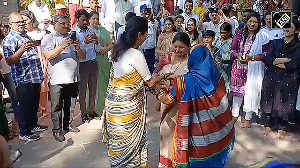The elections are not only a means for TMC to prove its wide, unopposed mass allegiance but also a way to bargain for national leadership among regional political parties on the road to New Delhi, reports Avishek Rakshit.

Elections in West Bengal have always been marred by violence and the panchayat polls on Monday are no exception. So far, at least three people have died in the run-up to the elections, and incidents of intimidation, violence, defection and horse trading in rural Bengal have become the order of the day.
Opposition parties in West Bengal, largely represented by the Bharatiya Janata Party, the Congress and the Left Front -- all having different ideologies, strategies and member bases -- remain far from putting up a united resistance to the ruling Trinamool Congress.
This time a record has been set in the state -- the TMC has already won 34 per cent of the total seats, mostly in Birbhum, Bankura, Murshidabad and South 24 Parganas districts. For these seats, the opposition parties did not field any candidate and the TMC won uncontested.
Of the 48,650 gram panchayats, the TMC has won 16,814 unopposed. Among the panchayat samitis, it has bagged 3,059 seats of the 9,217 uncontested, and in zila parishads, of the 825 seats, it has won 203 seats in face of no opposition.
This is only the third time that the percentage of panchayat seats won unopposed by a party in the state is in double digits. Earlier, in 2013, the TMC had won 10.66 per cent of the panchayat seats uncontested, and in 2003, the Left Front, led by the Communist Party of India-Marxist had won 11 per cent uncontested.
While TMC leaders credited their victories to the “development agenda and the good work done by Chief Minister Mamata Banerjee” so far, the opposition parties cried foul, accusing TMC members of bullying their potential candidates, leading to the withdrawal of candidature.
Adhir Chowdhury, state president of the Congress, alleged the State Election Commission and the TMC were hand-in-glove and the TMC’s attacks on Congress workers and potential candidates forced them “either not to contest at all or withdraw their nominations”. The Calcutta high court had to extend the deadline for filing nominations after it heard a petition from the Congress.
The TMC has pulled back 9,574 nominations, the BJP 5,574 and the CPI-M 3,127. The Congress has withdrawn 1,738 candidates, while others and Independents have taken back 23,619 nominations.
The SEC has decided to conduct a one-day election on May 14 in 58,500 booths, scattered over 43,000 locations. The exercise will need at least 85,000 security persons, but the state can arrange for only 46,000. The rest is likely to come from neighbouring states.
However, the SEC’s decision on a single-day poll has irked the opposition parties, which accused the commission of colluding with the TMC.
Abdul Mannan, leader of the Opposition at the assembly, has alleged the Left Front government, led by Jyoti Basu, crippled the SEC by bringing in the West Bengal State Election Commission Act, 1994.
“It was basically a lack of vision. The Left Front used to rig the polls before and thus passed such an Act, reducing the powers and stature of the SEC, hoping its government will last forever. Now, the TMC is using that Act to the hilt,” said Mannan, who is from the Congress.
The Congress and the Left contested the 2016 assembly polls and several bypolls together. Although in the past these two parties were inimical towards each other, the rise of the TMC has brought them on a common platform. But, major differences between them remain.
Congress leaders allege that the Left Front imposes its decisions on them and ask them to fall in line. Workers of both groups admit that coordination between them remains a key issue and thus a unified opposition cannot be mounted.
“Moreover, in the 2016 assembly elections, none of the Left Front leaders met the Congress high command even after an alliance was announced. It did not go down well with Congress workers and it was reflected in the number of seats the Left Front won in the elections,” Mannan said.
On the other hand, the Left Front and the Congress, which see the BJP as communal, have maintained a distance from the saffron outfit. As a result, a united opposition remains far from reality in the state.
It is almost certain that the TMC is poised to sweep the elections. Its leaders who are leaving no stone unturned -- from poaching former CPI-M leaders like Choton Kisku to taking out mass rallies to garner support, which often leads to violence -- view this election as one of utmost importance for the party.
Eyeing an anti-BJP front for the 2019 Lok Sabha elections, the TMC has been talking to other political parties to float a front to unsettle the Narendra Modi government and emerge as a strong political force nationally. However, its ambitions in Tripura were jolted after the BJP overthrew the Left Front there.
Now, the panchayat elections have not only become a means for the TMC to prove its wide, unopposed mass allegiance but also a way to bargain for national leadership among regional political parties in the road to New Delhi.
Subrata Mukherjee, West Bengal’s panchayat and rural development minister, is of the view that for any political party, the show of mass support and grassroots presence is crucial for inter-party bargains and the TMC is no exception.












 © 2025 Rediff.com -
© 2025 Rediff.com -